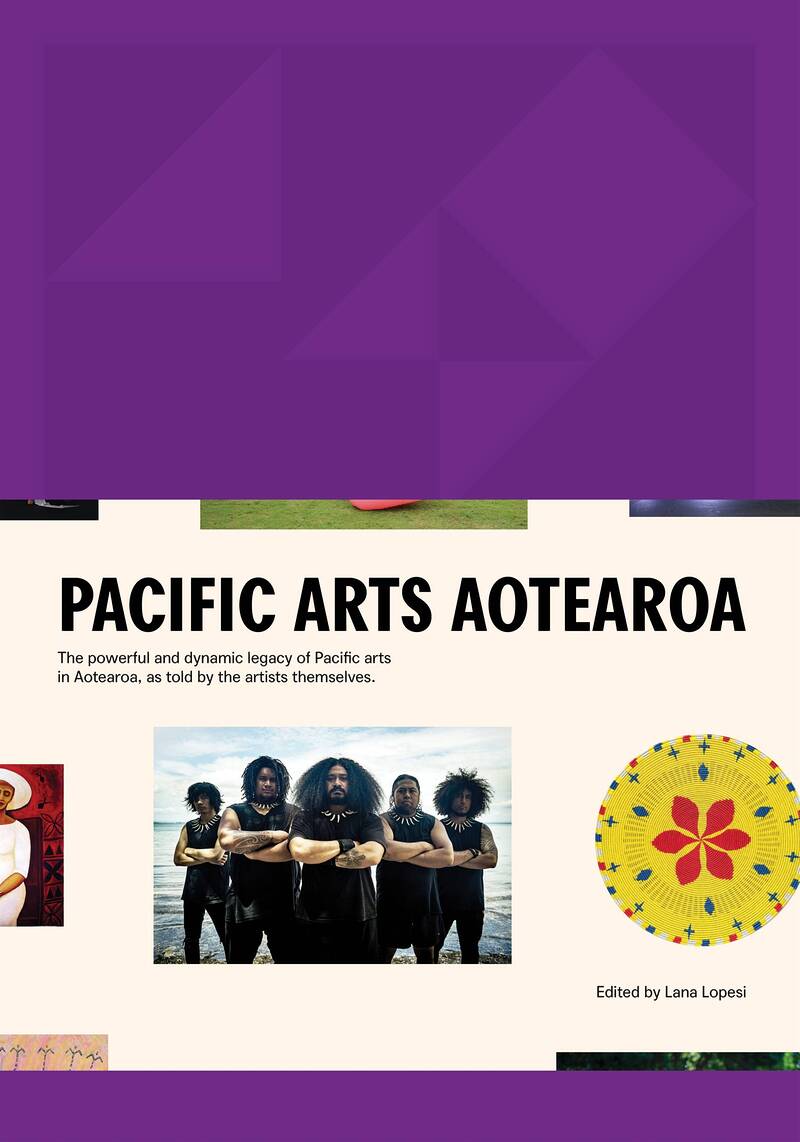The ‘creative contribution Pacific artists have made has been profound,’ Lana Lopesi said in a Radio New Zealand interview earlier this year, ‘and yet we have been underrepresented in art historical discourses across every art form.’
This impressive volume, designed by Shaun Naufahu, is Lopesi’s response, spanning over 500 pages of experiences, perspectives and images by artists – writers, architects, installation and performance artists, comedians, designers and curators (including myself), as well trans-disciplinary individuals and collectives, futurists and illustrators, and experts in weaving, tapa, tatau and spoken word.
Lopesi, an art critic now teaching at the University of Oregon, shapes the narratives of diverse practices in ways that create new, coherent ways to understand art making and its histories in Pacific contexts in Aotearoa. Chapters are generally designed around nine or ten practitioners, including makers describing their processes to reflections on documentary heritage, histories of place or landmark events. In a departure from dominant modes of art writing and criticism, artists have been invited to write about their own practices.
In Pacific Arts Aotearoa established artists such as Fatu Feu’u, Neil Ieremia and Selina Tusitala Marsh reflect on their work but often these stories lead to other places, like the casual racism experienced by our Poet Laureate or the influence of artist Tony Fomison on Fatu’s practice. Biography is integral to these reflections and the specificity of the experiences like that of Angela Tiatia growing up in Velvet Crescent, Otara or John Pule’s introduction to poetry through the Listener magazine unravel expectations about artistic motivation but also expectations of who Pacific peoples are.
Natasha Matila-Smith’s self-reflexive, self-deprecating devotion to desire and auto-ethnography describes advice given at art school where she was encouraged to make art about
all the things I’m disadvantaged by, being a Samoan, Māori and Pākehā woman. So why not make art about the struggles associated with that? That was about as disingenuous as it got, because the universal desire to be loved was more urgent and being brown was only ever an issue when others brought it up.
Racism – in both blunt and covert forms – inform many of the political, institutional and media constructions of Pacificness in Aotearoa. Earlier this year ACT party leader David Seymour tapped into a readymade well of prejudice when, with impunity, he suggested the Ministry of Pacific Peoples be blown up earlier this year. (‘In my fantasy, we’d send a guy called Guy Fawkes in there and it’d be all over ‘). The arts, however, resist negative depictions of Pacific people and powerfully assert Pacific identities on their own terms.
Lopesi makes plenty of room for the multiplicity of these approaches. In ‘Pacific Punk’, writer Huni Mancini delves into the DIY music scene, with insights on the Coolies, Coco Solid, the Mint Chicks, LEAO and indie metallers Shepherd’s Reign amongst others. Litia Tuiburelevu, in ‘Enduring Fights & Revolutionary Tendencies’, articulates the importance of Pacific Futurism, drawing on the work of the Pacific Sisters, Coco Solid, Tanu Gago as well Gina Cole’s ‘writing beyond empire’ because:
visualising, actualising and manifesting new worlds threatens the implacability of power unjustly formed. By (re)presenting our Moana subjectivities as the source of order, new futures emerge that aren’t refracted through the colonial prism. We are what we remember, we are what we imagine.
Radical acts of reclamation and imagination are embedded in all of the stories. This may be the ‘mafanafana’ (warmth) Faith Wilson ascribes to Ahilapapa Rands and Maila Urale’s Moana Fresh store and gallery space; or the heavily redacted and iterative piece by Lindah Lepou; or Teokota‘i Paitai’s lyrical vison of their dance journey and ‘lifetimes rushing through our veins’; or the gafa and papa‘anga (whakapapa) scattered throughout the pages as artists tell stories that are inevitably of their kupuna as well. Pelenakeke Brown, a dancer and artist, wonders ‘what would a Moana-centric understanding of disability (in all its glory and nuance) look like?’
Radicalism is in the commitment to empowerment and community imagined by artist Janet Lilo. She describes a kaupapa she devised for herself when she graduated from art school: ‘I would like to engage, involve, research and educate diverse communities using visual art and creative processes as a platform for learning and empowerment’. Many in Pacific Arts Aotearoa share this sense of obligation to collective wellbeing. Many also acknowledge artistic forebears and mentors such as the late Jim Vivieaere, a multimedia artist and groundbreaking curator, valued mentor to me and many others in the book, or document the heritage and importance of Mana newspaper and the Polynesian Bookshop and Press.
Pacific Arts Aotearoa is valuable as social history, exploring the breadth and depth of Pacific engagement in the life of Aotearoa New Zealand, with many instances of common cause and allyship with tangata whenua. The essays here centre the arts as a vital dimension of Pacific lives and experience, integrating politics, music, collectivity, cosmopolitanism, diaspora and resistance. They’re also a celebration, as artist and educator Lily Laita, who passed away not long after the book was published, suggests:
I think of art as a bodily function – a continuation of ‘play’ that is the primal language, in that it is a form of communication even before we learn to talanoa. I think it integral to everything you do: your man, aura/au ra – what signifies you as an individual and marks your difference. […] I simply love the process of making – fai fai fai; it is my happy place.



